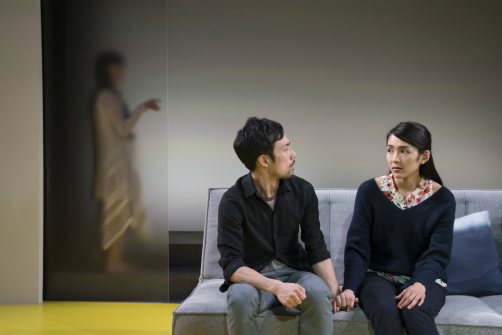
Time's Journey Through A Room
By Toshiki Okada; English translation by Aya Ogawa
Directed by Dan Rothenberg
Produced by The Play Company
Off Broadway, Play
Runs through 6.10.18
A.R.T./N.Y. Theatres, 502 West 53rd Street
by Ran Xia on 5.20.18
 Kensaku Shinohara and Maho Honda in Time's Journey Through A Room. Photo by Julieta Cervantes.
Kensaku Shinohara and Maho Honda in Time's Journey Through A Room. Photo by Julieta Cervantes.
BOTTOM LINE: Time's Journey Through a Room is Toshiki Okada's multi-layered exploration of how we process trauma and loss.
What is the sound of a disaster? Is it explicitly violent, or maybe something completely unexpected, a trigger that brings you back to a moment? What about tragedy? Does it become a prison—a room you can't escape? Or is it a shelter—a cocoon you wrap yourself into, so that time stops and the future is shut out, like the rest of the world? These are just a few of the grand and thoroughly complex questions playwright Toshiki Okada raises with his deceptively minimalist Time's Journey Through a Room, in which time is a character more than an abstract concept, and the room is more than just a space we can walk across.
Set designer Anna Kiraly's vision of the room in question is simple and wide; the floor is painted bright yellow and the walls are a warm white with some taped outlines that seem to mark shadows or the passing sun. The sparse furniture, straight out of a Muji catalogue, creates a stark construct, with lots of negative space. The room is charged. And the three characters sharing this space remain shrouded in an air of mystery. There's Kazuki (Kensaku Shinohara), who sits still with his back towards us. There is his wife Honoko (Yuki Kawahisa) and her wandering, strangely optimistic presence. And lastly, there is actor Maho Honda, who communicates directly with the audience, interrupting any speculation you might have to ask you about all the sound you can no longer hear.
Honda addresses us in a deliberately awkward way and reveals her character Arisa's role from the get go: Arisa is slowly approaching the room where she will become Kazuki's new girlfriend. But not yet, Hondo insists. Arisa is caught in traffic, and will eventually sprinkle some of the most mundane details into this heightened, Murakami-esque drama that uses the language of ghosts to justify the simultaneous presence of the past, the present, and the future. Another juxtaposition comes from the play being at once candid and enigmatic. It doesn't hide any secrets, but it deliberately takes its time to explain and evolve the relationships between the three people, and to unravel the different layers of metaphor at work.
There's an interesting art installation intro to this production (which is not in the script): a cube-like shadow box turns into a futuristic portal of light before the stage opens to reveal the more realistic room. This collaboration between Kiraly, lighting designer Amith Chandrashaker, and sound designer Mikaal Sulaiman, adds a bit of suspense and readies your mind for abstraction, which is helpful in this case. If you try to understand Time's Journey as a traditional relationship drama, you might become disappointed by the lack of action. Another sticking point for American audiences might stem from the ultra-polite use of language that is typical in Japanese culture: it takes the better half of an entire scene for Arisa to finally step across the threshold of the room, and for the two soon-to-be lovers to finally share a couch.
Set in the aftermath of Japan's 2011 earthquake, Time's Journey allows us to look into the ordinary lives of Japanese people through a lens that is both abstract and deeply personal. So it's also a mistake to interpret these characters simply as people. For instance, Kazuki very much represents an everyman who struggles to move beyond his past and welcome the future. Whereas Honoko is focused on describing her elated state during the days after the earthquake, and her improved relationship with Kazuki, which becomes "better than ever." But what she remembers the most about the earthquake is not the sound of sirens or the scenes of destruction, but rather the people helping each other.
And perhaps that's the purpose of Okada's theatrical saga—to start a process of healing after a profound loss that is shared by many. Although Time's Journey is in many ways uniquely Japanese, it is also astutely relevant to anyone who has experienced loss, grief, and trauma. Especially in New York City, where memories of 9/11 are still fresh almost 20 years later, Time's Journey Through a Room will no doubt resonate with many; like Honoko does with Kazuki, the play may well linger in your mind long after time has supposedly moved on.
(Time's Journey Through A Room plays at A.R.T./N.Y. Theatres, 502 West 53rd Street, through June 10, 2018. Running time is 1 hour with no intermission. Performances are Mondays at 7:30; Wednesdays through Saturdays at 7:30; and Sundays at 4. There is a matinee Friday 6/1 at 3. Tickets are $35 ($45 premium), with $15 student tickets, and are available at playco.org or by calling 866-811-4111.)
Time's Journey Through A Room is by Toshiki Okada with English translation by Aya Ogawa. Directed by Dan Rothenberg. Set Design by Anna Kiraly. Costume Design by Maiko Matsushima. Lighting Design by Amith Chandrashaker. Sound Design by Mikaal Sulaiman. Production Stage Manager is Molly Shea. Production Manager is Anchor Watch.
The cast is Yuki Kawahisa, Maho Honda, and Kensaku Shinohara.

